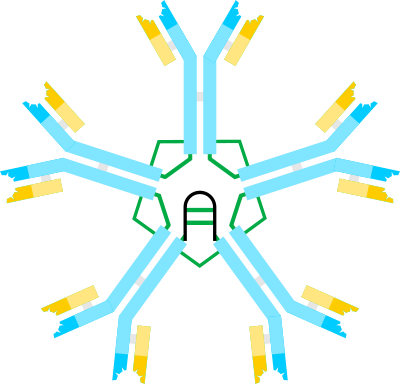WBR0681
| Author | [[PageAuthor::Serge Korjian M.D. (Reviewed by Serge Korjian)]] |
|---|---|
| Exam Type | ExamType::USMLE Step 1 |
| Main Category | MainCategory::Immunology |
| Sub Category | SubCategory::General Principles |
| Prompt | [[Prompt::A 1-year-old boy is brought by his mother to the pediatrics clinic for recurrent infections. Following a complete work-up, the patient is found to have very elevated serum concentrations of the immunoglobulin shown below. The patient also has deficient serum concentrations of all other immunoglobulin classes. Which of the following best characterizes the patient's condition? |
| Answer A | AnswerA::Defect in B-cell maturation |
| Answer A Explanation | AnswerAExp::Common variable immunodeficiency (CVID) is due to a defect in B-cell maturation. |
| Answer B | AnswerB::Inability of T cells to reorganize actin cytoskeleton |
| Answer B Explanation | AnswerBExp::Wiskott-Aldrich syndrome is characterized by the inability of T cells to reorganize actin cytoskeleton. |
| Answer C | AnswerC::Failure of Th1 cells to produce IFN-gamma |
| Answer C Explanation | AnswerCExp::Hyper-IgE syndrome is characterized by the failure of Th1 cells to produce IFN-gamma. |
| Answer D | AnswerD::Defect of the BTK gene |
| Answer D Explanation | AnswerDExp::X-linked (Bruton's) agammaglobulinemia is characterized by a defective BTK gene. |
| Answer E | AnswerE::Defective CD40L on helper T cells |
| Answer E Explanation | AnswerEExp::Hyper-IgM syndrome is characterized by defective CD40L on helper T cells |
| Right Answer | RightAnswer::E |
| Explanation | [[Explanation::The patient has elevated levels of IgM, which is a pentamer that is produced in the immediate response against pathogens. The shape of IgM is important to allow it to maximally trap antigens. Given the patient's elevated IgM, and deficiency of all other Ig classes, he most likely suffers from hyper IgM syndrome. Hyper IgM syndrome (type 1)is an X-linked disorder caused by a defective CD40L on helper T cells. CD40L (L for Ligand) binds to CD40 on antigen presenting cells, and it's deficiency or mutation prevents immunoglobulin class switching, leading to a deficiency in all classes of immunoglobulin except IgM the primary immunoglobulin produced by B-cells during an antigen response. Four other types of hyper IgM syndrome have bee characterized, all with different modes of inheritance and different mutations involving any of the receptors involved in immunoglobulin class switching. Patients with hyper IgM syndrome classically present with recurrent pyogenic infections (among which Pneumocystis jirovecii pneumonia is very common) due to the inability to mount an appropriate immune response, particularly with the lack of secretory IgA. Educational Objective: IgM is a pentamer. It is increased in hyper IgM syndrome, that is commonly caused by a defective CD40L on helper T cells. |
| Approved | Approved::Yes |
| Keyword | WBRKeyword::Hyper IgM, WBRKeyword::hyper-IgM, WBRKeyword::Recurrent infection, WBRKeyword::Infections, WBRKeyword::CD40L, WBRKeyword::Class switching, WBRKeyword::Immunoglobulin, WBRKeyword::Pentamer |
| Linked Question | Linked:: |
| Order in Linked Questions | LinkedOrder:: |
